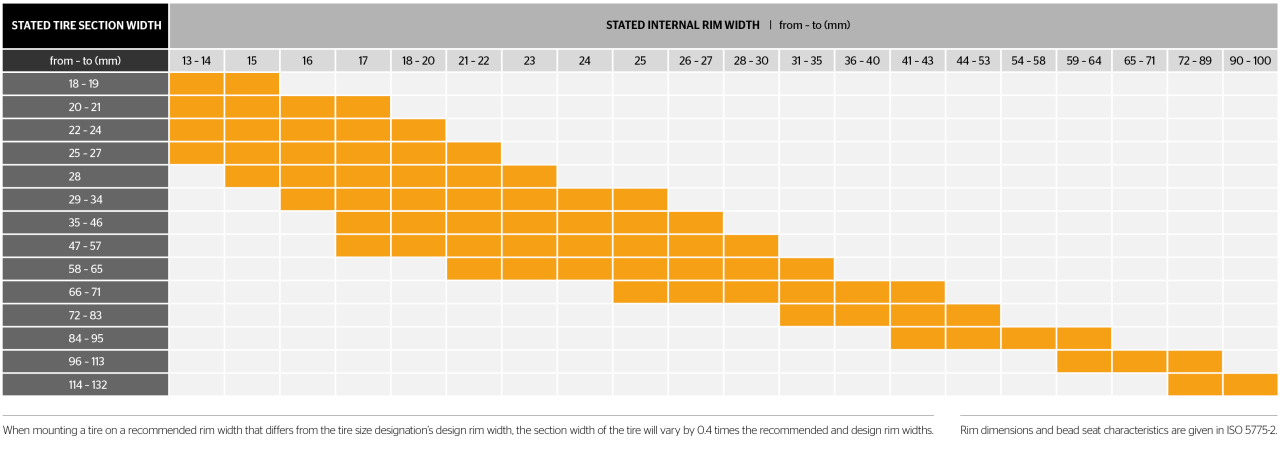#Tire Knowledge #Bicycle
Tire/Rim Combinations | ETRTO Standards
General Information on Tire/Rim Combinations | ETRTO Standards
The tires are the only point of contact with the ground a bike has when riding. All riding forces are absorbed by the tire and transferred to the rims and other components. So, it is important to make sure that the components used in the tire system are compatible with each other.
The ETRTO, or European Tyre and Rim Technical Organisation, is a standards organization focused on tires and rims for vehicles in Europe. They establish standards and guidelines to ensure safety, compatibility and performance of tires and rims across different vehicles, promoting uniformity and reliability in the industry.
Therefore, Continental develops and designs bicycle tires according to the ETRTO recommendations and ISO standards. Continental's defined mounting guidelines and permitted values (e.g. max. inner rim width and max. pressure), according to the ETRTO recommendations ensure maximum safety when using both hooked and hookless rims. To ensure secure tire and rim combinations, it is mandatory to check and follow the guidelines/standards of both the tire and the rim very carefully, especially when using hookless rims. The maximum inflation pressure and permitted inner rim width are crucial for hookless applications.
Continental’s safety recommendations for inner tubes setups:
- Before mounting the tires, check all components (rim, tire, inner tube, rim tape) for damage. Damaged parts should always be replaced to ensure maximum safety. Check the tire inside for sharp obstacles that might damage the inner tube.
- Follow Continental’s mounting and care instructions for bicycle tires.
- Always check the compatibility of tire and rim. Therefore, check the tire packaging and the information of your rim provided by the rim manufacturer.
- Always check the maximum inflation pressure and maximum inner rim width of the tire on its packaging. Never exceed the permitted values! Be aware that they differentiate between different models and size designations.
- Always check the rim manufacturer’s guidelines. Be aware that the maximum tire pressure and maximum inner rim width stated by rim manufacturer and tire manufacturer for a specific tire size can differentiate. If they do, the lowest value is the one to follow.
Example:
• Max. pressure by tire manufacturer for a 28-622 tire is 6 bar | 87 psi
• Max. pressure by rim manufacturer for a 28-622 tire is 7 bar | 101 psi
→ follow the lower value, in this case 6 bar | 87 psi inflation pressure
- Never exceed the maximum inflation pressure listed for your tire. The inflation pressure should be checked before every ride. Always keep possible temperature differences between where the inflation pressure is checked and where the bike is ridden or stored in mind. With rising temperatures, the pressure inside the tire rises as well and can potentially exceed the maximum inflation pressure. With every 10°C | 18°F rise in temperature, the inflation pressure increases by roughly 0.17 bar | 2.5 PSI! If the actual inflation pressure exceeds the maximum pressure, safe usage of the tire cannot be ensured!
At Continental, rider safety is our number one priority. In case of questions or concerns, please don't hesitate to contact Continental customer support.
Compatible tire and rim combinations according to the 2024 ETRTO recommendations
Note: When developing bicycle tires, Continental observes the ETRTO recommendation valid at the time of development. These recommendations may change when the ETRTO publishes new guidance, but this does not invalidate them. Continental recommends to always follow the permitted values written on the tire packaging.

Actual tire width according to rim width:
The nominal tire width is based on the measurement with a measuring rim. If the internal width on which a tire is mounted differs from the internal width of the measuring rim, the actual tire width changes. The deviation depends on the difference between the internal width selected by Continental and the internal width of your rim. The internal width of Continental’s design rim is based on ETRTO recommendations.
For clincher tires, the width will be affected by 0.4 mm for each millimeter your rim width differs from Continental’s measuring rim.
Example 1: 28 mm Grand Prix 5000 S TR
Inner rim width | 15c | 17c | 19c measuring rim | 21c | 23c |
Tire width | 26.4 mm | 27.2 mm | 28.0 mm | 28.8 mm | 29.6 mm |
Example 2: 25 mm Grand Prix 5000
Inner rim width | 13c | 15c measuring rim | 17c | 19c | 21c |
Tire width | 24.7 mm | 25.5 mm | 26.3 mm | 27.1 mm | 27.9 mm |
FAQ
The maximum tire width that can be mounted is limited by your brake system and frame dimensions. Please refer to your bike instructions. The dimensions of the installed rims limit the possible tire dimensions as well. Please pay attention to the specifications of your rims.
During the lifetime of a tire, there may be slight stretching of the tire during use. Our internal clearance tests ensure that it does not exceed the nominal width of the tire on the reference rim.